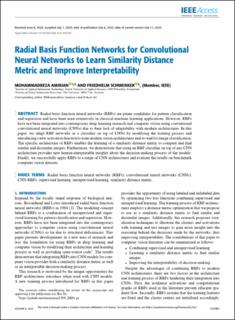Please use this identifier to cite or link to this item:
https://doi.org/10.21256/zhaw-26284Full metadata record
| DC Field | Value | Language |
|---|---|---|
| dc.contributor.author | Amirian, Mohammadreza | - |
| dc.contributor.author | Schwenker, Friedhelm | - |
| dc.date.accessioned | 2022-12-02T14:02:44Z | - |
| dc.date.available | 2022-12-02T14:02:44Z | - |
| dc.date.issued | 2020 | - |
| dc.identifier.issn | 2169-3536 | de_CH |
| dc.identifier.uri | https://digitalcollection.zhaw.ch/handle/11475/26284 | - |
| dc.description.abstract | Radial basis function neural networks (RBFs) are prime candidates for pattern classification and regression and have been used extensively in classical machine learning applications. However, RBFs have not been integrated into contemporary deep learning research and computer vision using conventional convolutional neural networks (CNNs) due to their lack of adaptability with modern architectures. In this paper, we adapt RBF networks as a classifier on top of CNNs by modifying the training process and introducing a new activation function to train modern vision architectures end-to-end for image classification. The specific architecture of RBFs enables the learning of a similarity distance metric to compare and find similar and dissimilar images. Furthermore, we demonstrate that using an RBF classifier on top of any CNN architecture provides new human-interpretable insights about the decision-making process of the models. Finally, we successfully apply RBFs to a range of CNN architectures and evaluate the results on benchmark computer vision datasets. | de_CH |
| dc.language.iso | en | de_CH |
| dc.publisher | IEEE | de_CH |
| dc.relation.ispartof | IEEE Access | de_CH |
| dc.rights | https://creativecommons.org/licenses/by/4.0/ | de_CH |
| dc.subject | Radial basis function neural network (RBF) | de_CH |
| dc.subject | Convolutional neural network (CNN) | de_CH |
| dc.subject | CNN-RBF | de_CH |
| dc.subject | Supervised learning | de_CH |
| dc.subject | Unsupervised learning | de_CH |
| dc.subject | Similarity distance metric | de_CH |
| dc.subject.ddc | 006: Spezielle Computerverfahren | de_CH |
| dc.title | Radial basis function networks for convolutional neural networks to learn similarity distance metric and improve interpretability | de_CH |
| dc.type | Beitrag in wissenschaftlicher Zeitschrift | de_CH |
| dcterms.type | Text | de_CH |
| zhaw.departement | School of Engineering | de_CH |
| zhaw.organisationalunit | Institut für Informatik (InIT) | de_CH |
| dc.identifier.doi | 10.1109/ACCESS.2020.3007337 | de_CH |
| dc.identifier.doi | 10.21256/zhaw-26284 | - |
| zhaw.funding.eu | No | de_CH |
| zhaw.originated.zhaw | Yes | de_CH |
| zhaw.pages.end | 123097 | de_CH |
| zhaw.pages.start | 123087 | de_CH |
| zhaw.publication.status | publishedVersion | de_CH |
| zhaw.volume | 8 | de_CH |
| zhaw.publication.review | Peer review (Publikation) | de_CH |
| zhaw.author.additional | No | de_CH |
| zhaw.display.portrait | Yes | de_CH |
| Appears in collections: | Publikationen School of Engineering | |
Files in This Item:
| File | Description | Size | Format | |
|---|---|---|---|---|
| 2020_Amirian-Schwenker_Radial-basis-function-networks-learn-similarity-distance-metric-improve-interpretability.pdf | 7.85 MB | Adobe PDF |  View/Open |
Show simple item record
Amirian, M., & Schwenker, F. (2020). Radial basis function networks for convolutional neural networks to learn similarity distance metric and improve interpretability. IEEE Access, 8, 123087–123097. https://doi.org/10.1109/ACCESS.2020.3007337
Amirian, M. and Schwenker, F. (2020) ‘Radial basis function networks for convolutional neural networks to learn similarity distance metric and improve interpretability’, IEEE Access, 8, pp. 123087–123097. Available at: https://doi.org/10.1109/ACCESS.2020.3007337.
M. Amirian and F. Schwenker, “Radial basis function networks for convolutional neural networks to learn similarity distance metric and improve interpretability,” IEEE Access, vol. 8, pp. 123087–123097, 2020, doi: 10.1109/ACCESS.2020.3007337.
AMIRIAN, Mohammadreza und Friedhelm SCHWENKER, 2020. Radial basis function networks for convolutional neural networks to learn similarity distance metric and improve interpretability. IEEE Access. 2020. Bd. 8, S. 123087–123097. DOI 10.1109/ACCESS.2020.3007337
Amirian, Mohammadreza, and Friedhelm Schwenker. 2020. “Radial Basis Function Networks for Convolutional Neural Networks to Learn Similarity Distance Metric and Improve Interpretability.” IEEE Access 8: 123087–97. https://doi.org/10.1109/ACCESS.2020.3007337.
Amirian, Mohammadreza, and Friedhelm Schwenker. “Radial Basis Function Networks for Convolutional Neural Networks to Learn Similarity Distance Metric and Improve Interpretability.” IEEE Access, vol. 8, 2020, pp. 123087–97, https://doi.org/10.1109/ACCESS.2020.3007337.
Items in DSpace are protected by copyright, with all rights reserved, unless otherwise indicated.